PESTS AND DISEASES OF FORESTRY IN NEW ZEALAND
Mountain beech moth
Scion is the leading provider of forest-related knowledge in New Zealand
Formerly known as the Forest Research Institute, Scion has been a leader in research relating to forest health for over 50 years. The Rotorua-based Crown Research Institute continues to provide science that will protect all forests from damage caused by insect pests, pathogens and weeds. The information presented below arises from these research activities.
Forest and Timber Insects in New Zealand No. 61.
Mountain beech moth.
Revised 2009
Based on M.J. Nutall (1984)
Insect: Proteodes carnifex (Butler) (Lepidoptera: Oecophoridae)
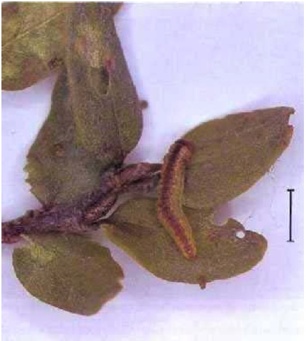
Fig. 1 - Caterpillar of the mountain beech moth.
The line shows natural length.
Type of injury
A newly-hatched caterpillar of the mountain beech moth feeds on the underside of leaves of its host tree by scraping out pinpoint holes between the leaf veins. On the upper leaf surface, which is not perforated, the feeding area becomes visible as a brownish discolouration, often with a patch of silvery-white cuticle that is still intact at its centre. At a later stage of growth the caterpillar transfers to the upper side of the leaf where it eats through about half the thickness of that surface. The remainder of the leaf turns brown and dies, resulting in a loss to the tree of twice the amount of foliage actually eaten (Fig. 2). In its final stage of growth the caterpillar moves freely on the remaining foliage and chews leaves from the edge right through their entire thickness. When defoliation is complete the caterpillar may chew the surface layer from small twigs, or nibble at buds which are just opening (Fig. 3).
Hosts
Caterpillars of this moth are usually found only on Nothofagus solandri solandri (black beech) and N. solandri cliffortioides (mountain beech), but they occasionally occur on N. fusca (red beech) and N. menziesii (silver beech) which are growing close to black or mountain beech.
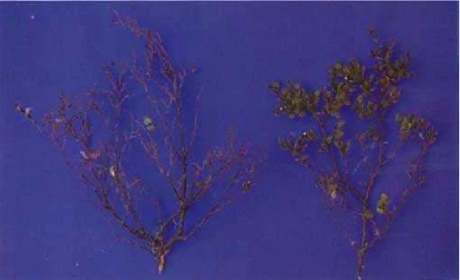
Fig. 2 - Heavy defoliation of mountain beech by caterpillars of the mountain beech moth.
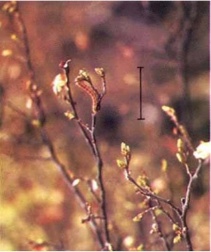
Fig. 3 - Caterpillar of the mountain beech moth nibbling at buds of mountain beech.
The line shows natural length.
Distribution
This insect is native to New Zealand and is present in most lowland, montane, and sub-alpine forests which contain black beech and mountain beech. Greatest numbers are usually found at altitudes above 300 m on the eastern side of the Main Divide in the South Island. The moth is rarely encountered in the North Island.
Economic importance
Since 1900 there have been a number of reports of widespread attack by the insect on high country mountain beech. For example, extensive defoliation occurred in the Lake Manapouri – Te Anau region in 1952-55, and again in 1965-70 and 1977-79. In these latter periods there was also considerable defoliation in other Fiordland forests, and in forest from just south of Lewis Pass to the Tasman Mountains in north Nelson (Fig. 4).
The forests concerned serve as high-country erosion control and anything that may affect this role is important. Fortunately epidemics fade away after 2-3 years, for even though all green foliage and buds may be destroyed the host trees retain a vigorous capacity for refoliation. The complete recovery of healthy trees is to be expected for both caterpillar and host have evolved together over a very long period of time. However, trees at the upper forest limit or those weakened by old age may suffer partial crown death and in some cases die. Tree seedlings in stressful situations which suffer defoliation two years in a row often perish, probably because they have insufficient reserves to produce a further crop of buds. Because defoliation allows more light to fall on the forest floor an uncharacteristic mat of vigorous grasses and weeds can develop, which can also adversely affect seedling growth.
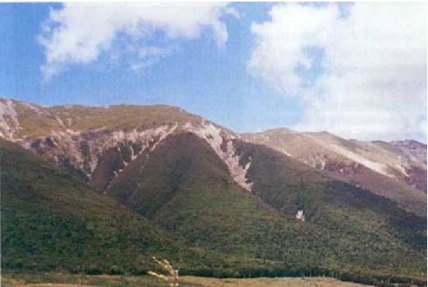
Fig. 4 - St Arnaud Range, Nelson Lakes National Park, January 1969. The many brown patches throughout this forest area, particularly in the upper zones, are mountain beech trees which have been severely affected by caterpillars of the mountain beech moth.
Description, life history, and habits
The moth (Fig. 5) has a wingspan of 18-22 mm. The forewings of the male are usually reddish grey while those of the female vary from greyish yellow to golden and from greyish red through orange to brownish grey. The markings of the forewings are constant: along the veins there are rows of dark spots and in the middle of each wing there is usually a dark crescent or “Y”-shaped mark pointing towards the front edge. The hindwings of both sexes are tinged from the edges inwards with the same basic colour as the forewings, while the front legs, like the front edge of the forewings, may have a reddish tone. In size, shape, and colouring the moths resemble faded or fallen mountain beech leaves.
The caterpillar (Fig. 1), which is rather stout and tapers towards the rear, has three pairs of thoracic legs and five pairs of "prolegs" on the abdomen. The head is yellowish brown or yellowish green, while the body is pale whitish- green or yellowish green with a broad, dark brownish-purple or yellowish- green stripe along the middle of the back, and a narrower stripe, usually green, along the sides. There is only one generation per year. In Nelson Lakes National Park the moths are on the wing in late summer (February to mid-March). They are daytime flyers and when inactive remain on the leaves of the food plant. They are not attracted to light at night.
Their egg capacity is about 300, but whether they live long enough to deposit this number is not known. Eggs are usually laid individually on the underside of leaves, with leaves in the top part of the crown being preferred. Although the current season's foliage is fully developed at the time of egg-laying, the female almost always deposits eggs on the previous year's leathery leaves unless these have been lost by total defoliation. Eggs hatch in about 14 days.
Upon hatching the caterpillar makes a shelter on the downy underside of the leaf using silk and chewed-off leaf hairs. Once it has completed this camouflage shelter the caterpillar starts to feed as previously described. New shelters are made as the caterpillar grows. Favoured refuges are the shrivelled, undeveloped, rolled-up leaves that often occur at the base of small branches of mountain beech. Also favoured are the deformed and curled leaves produced on branches affected by shoot-mining weevil grubs (Neomycta). If temperature falls below a critical point a very compact shelter is constructed which is completely sealed except for a small entrance.
Frequently the undersides of two leaves are connected with silk threads and the shelter installed in the narrow gap between them.
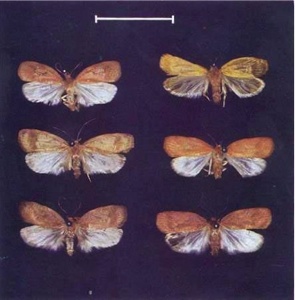
Fig. 5 - Mountain beech moths; males at left, females at right.
The line shows approximate wingspan.
Because mountain beech is an evergreen, a food supply is available throughout the winter, and caterpillars emerge at every favourable opportunity to eat. During winter the caterpillars moult from second to third stages and by September are about 8 mm long. By the end of October they attain the fourth stage. With the arrival of warmer weather, caterpillar development proceeds rapidly and by the end of November many are already in their fifth stage, feeding on the upper surface of the leaves and making shelters from a number of dead, dried-up leaves joined together with a few threads. With the attainment of the sixth and final stage of their growth the caterpillars cease spinning for shelter and move freely on the foliage. Movement is aided by webs which can cover all twigs and branches when population numbers are high.
The distribution of caterpillars in the crown of the tree changes as their development proceeds. Small caterpillars are at first concentrated on the uppermost branches, but move down into the lower region of the crown as they grow older. The most voracious final caterpillar stage is found on the lower branches and young growth where it devours the remaining leaves and then often destroys the buds.
About mid-January the caterpillar spins a number of leaves together and pupates within. The pupa is short, stout, and irregularly shaded with brown (Fig. 6). The moth emerges after 14 days.
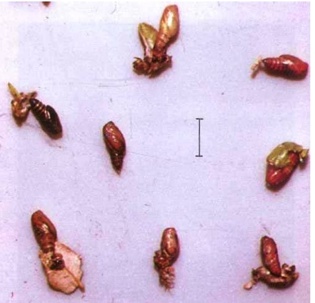
Fig. 6 - Pupae of the mountain beech moth.
The line shows natural length.
Details of the life history described here have been obtained from a study in Nelson Lakes National Park, and some variations occur in other localities. For example, in Fiordland National Park, some 500 km to the south, the flight period of the moth is mid-December to mid-January, and caterpillars reach their final stage at the end of September. Caterpillars there also have a smaller increase in size between each moult and may go through seven stages before being mature enough for pupation.
Control
When caterpillar numbers become high in the area the incidence of natural enemies is also greater: known natural enemies are a minute trichogrammatid wasp that has been recorded as parasitising up to 95% of eggs (Fig. 7); a eulophid wasp, two species of braconid wasp, and two species of tachinid flies (Fig. 8) parasitic on the caterpillars; and a eulophid wasp and an ichneumonid wasp that lay eggs into the pupae. Caterpillars are frequently infested with nematode worms. Many dead, misshapen caterpillars and pupae are also found when population numbers are high. The cause of such deformities is unknown but may be the result of starvation or a disease.
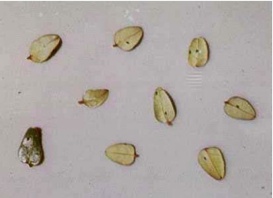
Fig. 7 - The black spots on these leaves of mountain beech are eggs of the mountain beech moth parasitised by a trichogrammatid wasp.
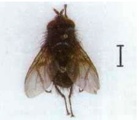
Fig. 8 - Pales funesta, a tachinid fly parasitic on caterpillars of the mountain beech moth.
Bibliography
Emberson, R.M. 1984: Forest and timber insects. In: Scott, R.R. (ed) New Zealand Pest and Beneficial Insects. Lincoln University, Canterbury, New Zealand. P 191-204.
Horak-Kaenel, M. 1970: Systematic and ecological study of Lepidoptera on Nothofagus cliffortioides in New Zealand. Unpublished thesis produced for E.T.H. Entomological Institute, Switzerland.
Hudson, G.V. 1928: The butterflies and Moths of New Zealand. Ferguson and Osborn, Wellington, 386 p.
Nuttall, M.J. 1984: Proteodes carnifex (Butler), (Lepidoptera: Oecophoridae). Mountain beech moth. New Zealand Forest Service, Forest and Timber Insects in New Zealand No. 61.
This information is intended for general interest only. It is not intended to be a substitute for specific specialist advice on any matter and should not be relied on for that purpose. Scion will not be liable for any direct, indirect, incidental, special, consequential or exemplary damages, loss of profits, or any other intangible losses that result from using the information provided on this site.
(Scion is the trading name of the New Zealand Forest Research Institute Limited.)

 Farm Forestry New Zealand
Farm Forestry New Zealand

